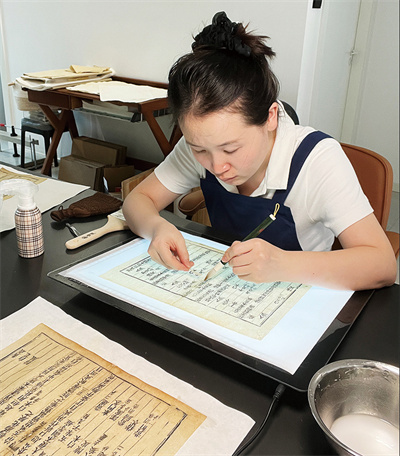
 0 Comment(s)
0 Comment(s) Print
Print E-mail China Daily, April 2, 2025
E-mail China Daily, April 2, 2025
At 30, Li Yangyang never imagined that her degree in international business would lead her to a career in ancient book restoration. From starting as a novice in the workplace to founding her own restoration studio, she spent six years carving out a niche in this specialized field.

Li Yangyang has built a career for herself in ancient book restoration. [Photo provided to China Daily]
Today, she not only restores valuable ancient texts but also inspires lots of young people to engage with this traditional craft through social media. Li's journey reflects the transformation of ancient book restoration from a perceived "old craft" into a vibrant, emerging field amid a broader revival of traditional culture.
In 2017, Li, a native of Wuhan in Hubei province, had just graduated from college and was exploring various job opportunities. Despite trying several roles, she felt unfulfilled.
One day, she came across a cultural technology company looking for ancient book restorers and offering training to apprentices with no prior experience. Intrigued, she submitted her resume and got the job.
For Li, ancient book restoration was an entirely new field. The company paired her with experienced colleagues for hands-on training and frequently invited renowned industry experts to give lectures.
After an intensive six-month apprenticeship, she began taking on simple restoration tasks independently.
Restoring ancient books is more challenging than it appears. A typical restoration project involves over 20 steps, including photographing for archival purposes, preparing paper materials, disassembling books, cleaning, binding, and more.
Depending on the extent of the damage, Li can restore anywhere from 30 pages to just one or two pages a day, with fees ranging from 20 to 200 yuan per page.
"Book bricks" is the colloquial term restorers use for ancient books that have hardened into solid blocks. Some books are so damp that the pages stick together completely, and even the initial step of "flattening the pages" can take an entire day, with the slightest mistake risking a tear.
Aesthetics pose another significant challenge. Ancient book restoration isn't just about "patching up" — the proportions of the margins and the color of the backing paper must align with the original book's character.
Li believes that working in ancient book restoration, especially for beginners, requires a sense of reverence and a calm mindset.
"Before starting a restoration, you must ask yourself: Can my skills handle this? If not, it's better to seek help from a master rather than risk making things worse," she explained. "Over-restoration can be more damaging than leaving the book untouched."
Li also advised that if you're feeling emotionally overwhelmed, it's best to avoid working on ancient books. She recalled a time when she nearly crumpled a book in frustration.
"Being overly joyful, laughing, or joking around isn't ideal either. Even cutting a millimeter too much can make restoration impossible later on."